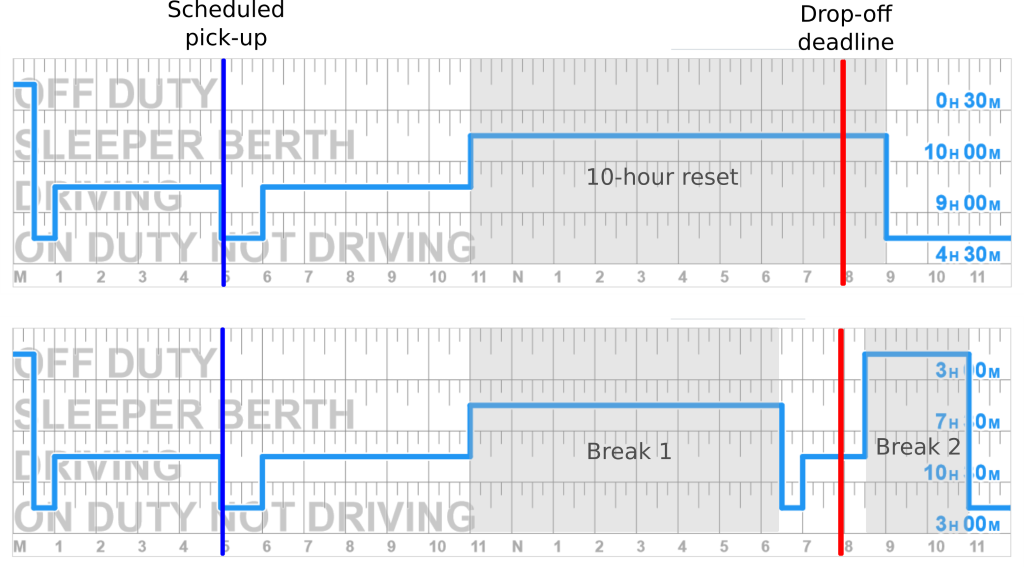Guide to the sleeper berth split (with log examples)
The sleeper berth provision adds flexibility to the hours of service rules that drivers can use to be more efficient (and well-rested).
Most new heavy-duty trucks are equipped with sleeper berths, so most OTR drivers can use the sleeper berth provision to schedule their shift around much-needed rest and load/unload times.
What is the sleeper berth provision?
The sleeper berth provision allows drivers of trucks equipped with a sleeper cab to split their 10-hour off-duty requirement into two breaks. The rule was modified in 2020 to be more flexible and much more usable by letting drivers "pause" their 14-hour clock while taking rest breaks during their shift.
This means rest periods can be scheduled around pickup or delivery times that wouldn't fit into a normal 14-hour shift. Instead of cramming 11 hours of driving into 14 consecutive hours, drivers can split driving hours with a longer break when they need some rest, without burning shift time.
What are the rules for a sleeper split?
- Drivers may split the consecutive 10 hours of off duty time into two breaks:
- One break of 7+ hours that must be spent in Sleeper Berth
- One break of 2+ hours that can be spent in Off Duty or Sleeper Berth
- The breaks may be taken in any order
- When added together, the breaks must equal 10+ hours of Off Duty and Sleeper Berth time
- When both breaks are completed, neither break period counts against the 14-hour clock
- The time immediately before and after each break cannot violate the 14-hour duty limit or the 11-hour driving limit
Example Split Shift
This driver had to drive 4 hours to get to his pickup scheduled at 5am. He gets his 30-minute break out of the way while waiting to get loaded. Then he's got another 5 hours of driving to get to his receiver. He can get there with time left over, no problem, except that their dock hours are from 3pm to 8pm. No matter how he tries to schedule it, a 10-hour reset won't allow him to unload during that time slot. You can see that in the first log graph below.
This is the perfect time to use the sleeper provision to split the off-duty time.
In the second log graph above, you can see how the driver could split his 10-hour break to get unloaded when he needs to.
The driver takes his long 7+ hour break once he's near the receiver. When he comes back on duty to get unloaded, he only needs to take the short 2+ hour break to complete the split shift properly.
How to do the math to get a split shift right
Let's look at the math a little more closely. Break 1 was 7.5 hours long and break 2 was 2.5 hours long. Since these add up to 10 hours, he completed the required rest breaks for a split shift.
We still have to keep in mind that last rule: The time immediately before and after each break cannot violate the 14-hour duty limit or the 11-hour driving limit.
So how did he do? We need to add up the total on-duty and driving time on either side of break 1 to find out.

He was on duty for 10.5 hours before, and 2 hours after break 1. Since these hours add up to 12.5 hours, he didn't violate the 14-hour duty limit.
He drove for 9 hours before, and 1.5 hours after break 1. Since these hours add up to 10.5 hours, he didn't violate the 11-hour driving limit.
What are his available hours after the split?
Here is where we get to another great perk of using a split shift in this scenario. Look back at the first log graph with the regular 10-hour reset. That driver is still loaded after he finishes the reset, and he has to wait until 3pm the next day to get unloaded during dock hours. That's a whole day wasted not moving cargo because of this too-tight schedule.
The driver that split his shift is unloaded and has plenty of available hours to be on his way. It's important to understand that completing a split shift doesn't reset the 11- and 14-hour clocks the way a consecutive 10 hours off duty does. To figure out how much time he can drive after break 2, he has to go by that same rule again: The time immediately before and after each break cannot violate the 14-hour duty limit or the 11-hour driving limit.
Before break 2 the driver was on duty for 2 hours. That leaves 12 hours of on-duty time available to use after break 2.
Before break 2 he drove 1.5 hours. That leaves 9.5 hours of drive time available to use after break 2.
He can get in almost a whole day of driving to pick up his next load.
Can you use a 10-hour reset as part of a split shift?
Yes, the FMCSA changed their guidance on this a few years ago. Drivers can take their short break first, and their long break can be 10 hours or more. In this case, when they come back from the long break, they'll have full 11- and 14-hour clocks just like any other 10-hour reset.
The sleeper berth provision is complicated, no doubt about it. Luckily, the Blue Ink Tech app can do the math for you, so you know when you need to take a break and how much drive and shift time you have available.
Check out the next split shift article: How does the BIT app calculate split shifts?
